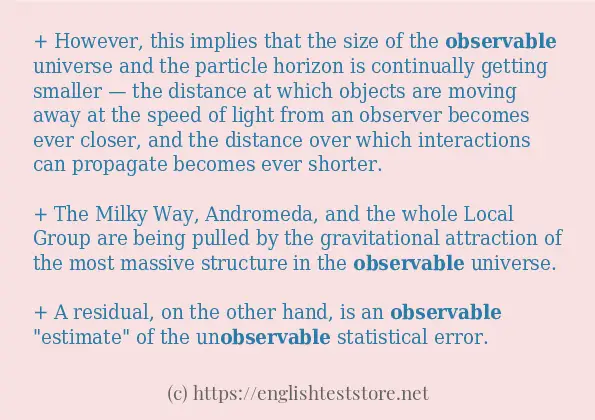How to use in-sentence of “observable”:
+ However, this implies that the size of the observable universe and the particle horizon is continually getting smaller — the distance at which objects are moving away at the speed of light from an observer becomes ever closer, and the distance over which interactions can propagate becomes ever shorter.
+ The Milky Way, Andromeda, and the whole Local Group are being pulled by the gravitational attraction of the most massive structure in the observable universe.
+ A residual, on the other hand, is an observable “estimate” of the unobservable statistical error.
+ There should, therefore, be no observable irregularities in the large scale structure.
+ The observable atmospheres of all these planets are quite thin compared to their radii, only extending perhaps one percent of the way to the center.
+ Helium is the second lightest element and is the second most abundant in the observable universe.
+ Every place in the universe has its own observable universe, which may or may not overlap with the one centered on Earth.
+ We call the part of the universe we can see the observable universe.

Example sentences of “observable”:
+ Even if every digit in Graham’s number were written in the tiniest writing possible, it would still be too big to fit in the observable universe.
+ The model says that after a finite time there will be a final singularity, called the “Big Rip”, in which the observable universe will reach zero size and all distances will reach into infinite value.
+ Galton used the term regression to describe an observable fact in the inheritance of multi-factorial quantitative genetic traits: namely that the offspring of parents who lie at the tails of the distribution will tend to lie closer to the centre, the mean, of the distribution.
+ They are one of the Observable universe#Large-scale structurelargest known structures in the cosmos.
+ The present area of directly observable lava flows is estimated to be around.
+ In effect, the space-time volume of the observable universe is expanding and Hubble’s law is the direct physical observation of this.
+ Two of the nonmetals—hydrogen and helium—make up over 99 per cent of the observable Universe, and one—oxygen—makes up close to half of the Earth’s crust, oceans and atmosphere.
+ Every location in the universe has its own observable universe, which may or may not overlap with the one centered on Earth.
+ The most common particles created in the big bang which are still easily observable to us today were protons.
+ Note that the idea that the radius of the observable universe must amount to only 13.8 billion light-years is incorrect.
+ It is also one of the largest and most luminous observable stars.
+ Thus the observable portions are gaseous.
+ The observable Universe contains more than 2 trillion.
+ According to Aristotle it was a readily observable truth that aphids arise from the dew which falls on plants, fleas from putrid matter, mice from dirty hay, crocodiles from logs rotting at the bottom of bodies of water, and so forth.
+ If the observable universe is smaller than the entire universe, observation is limited to a part of the whole.
+ By travelling, an observer can come into contact with a greater region of space-time than an observer who remains still, so that the observable Universe for the former is larger than for the latter.
+ These may span between several hundred million light-years to 10 billion light-years, and cover more than 5% of the observable universe.
+ Even if every digit in Graham's number were written in the tiniest writing possible, it would still be too big to fit in the observable universe.
+ The model says that after a finite time there will be a final singularity, called the "Big Rip", in which the observable universe will reach zero size and all distances will reach into infinite value.
